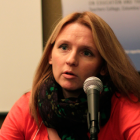By Nick Pandolfo
Buffy Hamilton, who calls herself “The Unquiet Librarian,” holds the phone receiver away from her ear at Creekview High School library in Canton, Ga., revealing a cacophony of noise in the background.
“It sounds like that a lot of the time,” says Hamilton, who welcomes what she calls “the hum of learning”—students talking about projects, watching videos and even singing “Happy Birthday.”
In 2009, Hamilton began re-imagining her role as a librarian at this new high public high school of 1,800 in the foothills of the Blue Ridge Mountains. In her new role, Hamilton focuses on enhancing lessons and class projects with tools of the digital world to access, organize and evaluate information.
Her job “is really about helping teachers and students explore new mediums for learning,” Hamilton says. “So that’s been a big shift.”
Creekview High School’s media center looks and sounds nothing like the silent libraries of the past. The new emphasis on collaborative learning and the use of digital tools to produce dynamic research projects lead to a louder, more hands-on environment that can prove beneficial to students later on in college. Hamilton says graduates have returned to thank her because their digital skills are more advanced than those of their classmates.
Hamilton’s transformation of the library’s role in this middle-class suburb evolved from her exposure to research and thinking by R. David Lankes, director of the master’s program in library and information science at Syracuse University, and Henry Jenkins, head of the comparative media studies program at MIT, among others, regarding the ways that digital natives learn through communication and collaboration. Her model challenges students to think more independently and go beyond a Google search to use digital media tools to deepen their researching, understanding and presentation of a topic.



